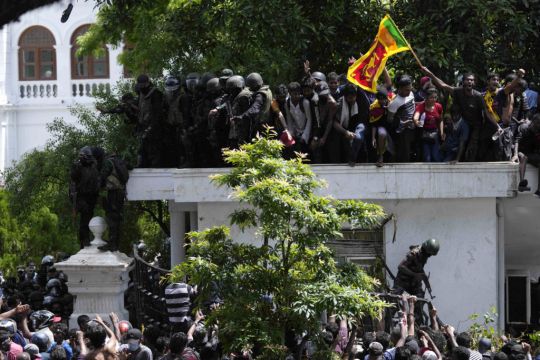Sri Lankans woke up to confusion on Thursday after their president did not deliver on his vow to resign by Wednesday evening.
President Gotabaya Rajapaksa and his wife fled to the Maldives on Wednesday aboard an air force jet. He made the prime minister acting president in his absence.
It was a move that further angered a public that blames Mr Rajapaksa for an economic crisis that has caused severe shortages of food and fuel.
Since Sri Lankan presidents are protected from arrest while in power it is likely he planned his escape while he still had constitutional immunity and access to a military jet.

It was unclear exactly where he was in the Maldives, an archipelago of hundreds of islands famed for luxury tourist resorts, and where he planned to travel next.
On Wednesday, protesters, undeterred by multiple rounds of tear gas, scaled the walls to enter the office of Prime Minister Ranil Wickremesinghe as the crowd outside cheered in support and tossed water bottles to them.
Protesters took turns posing at the prime minister’s desk or stood on a rooftop terrace waving the Sri Lankan flag after the latest in a series of takeovers of government buildings by the demonstrators — who see the political manoeuvres as delaying their goal of a new government.
Late on Wednesday night, crowds also gathered outside the parliament. Demonstrators clashed with security officers who fired tear gas into the air.

Mr Wickremesinghe’s office declared a nationwide curfew and imposed a state of emergency giving broader powers to the military and police. The curfew was lifted early on Thursday.
Over the weekend, the two leaders both said they would resign after protesters stormed their official residences in a dramatic escalation of months of protests. Some set fire to Mr Wickremesinghe’s private residence, and his whereabouts were unknown.
The protesters blame Mr Rajapaksa and his powerful, dynastic family for leading the country into an economic abyss, but they are also furious with Mr Wickremesinghe, whom they accuse of protecting the president. Many believe that his appointment in May alleviated pressure on Mr Rajapaksa to resign.
“We need both… to go home,” said Supun Eranga, a 28-year-old civil servant in the crowd on Wednesday. “Ranil couldn’t deliver what he promised during his two months, so he should quit. All Ranil did was try to protect the Rajapaksas.”
But Mr Wickremesinghe has said he will not leave until a new government is in place. He has urged the speaker of parliament to find a new prime minister agreeable to both the ruling and opposition parties.
It is unclear when that might happen since the opposition is deeply fractured.
But assuming that Mr Rajapaksa resigns as planned, Sri Lankan lawmakers have agreed to elect a new president on July 20 who will serve the remainder of Mr Rajapaksa’s term, which ends in 2024. That person could potentially appoint a new prime minister, who would then have to be approved by parliament.
The political impasse threatens to worsen the bankrupt nation’s economic collapse since the absence of an alternative government could delay a hoped-for bailout from the International Monetary Fund. In the meantime, the country is relying on aid from neighbouring India and from China.







